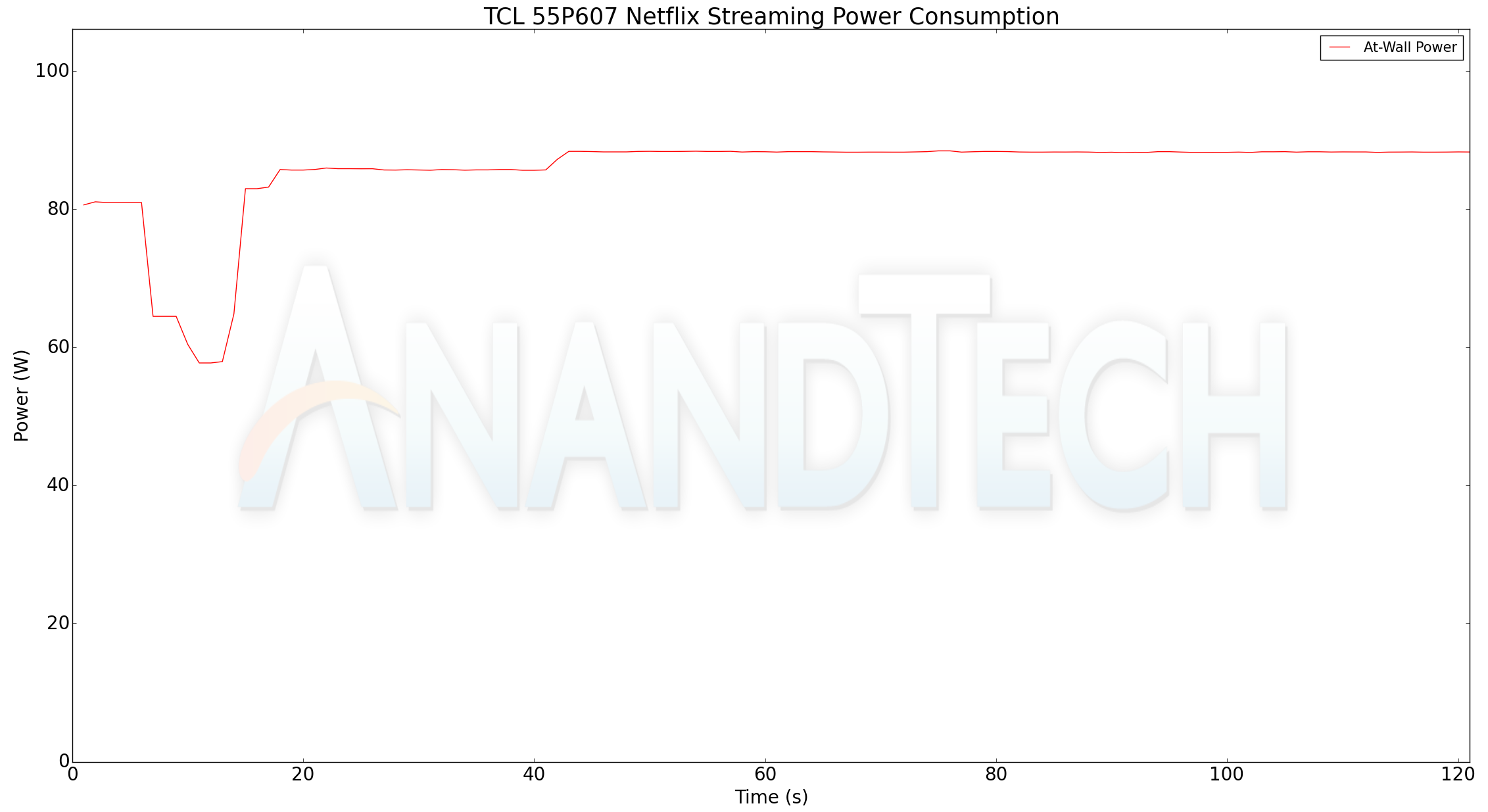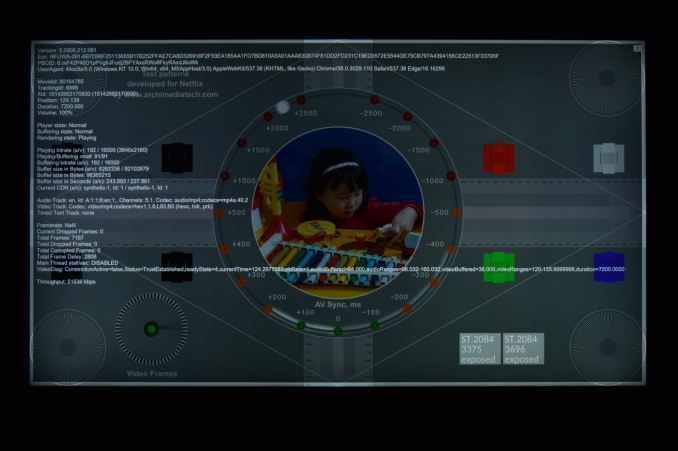A Budget Home Theater & PC Setup: 4K, HDR, UHD Blu-ray, and More
by Ganesh T S on December 26, 2017 8:30 AM ESTNetflix Streaming
We have been using Netflix's El Fuente test clip to evaluate the Netflix streaming capabilities of various HTPCs. Though it does have 4K streams at bitrates of up to 16 Mbps, it doesn't have a HDR version. Our search for a suitable test stream ended with Season 4 Episode 4 of the Netflix Test Pattern series.
The TCL 55P607's Roku platform has a Netflix app. It was able to play the 16 Mbps 4K Dolby Vision version along with Dolby Digital Plus 5.1 audio that was sent back to the receiver using the ARC feature.
Netflix 4K Dolby Vision HDR Stream in the TCL 55P607
Note that the SMPTE text in the boxes are related to the HDR metadata. As we shall see further down, the non-HDR versions of the clip have blank white boxes in that space.
The NVIDIA SATV's Netflix app plays the HDR10 version of the clip, as evident from the stream information detected by the TV.
Netflix 4K HDR10 Stream in the NVIDIA SHIELD Android TV
Our test clip is not suitable for bringing out the advantages of dynamic metadata / Dolby Vision, but, suffice to say that the SATV's Netflix HDR capabilities are compatible with every HDR TV currently in the market.
On the PC front, we have Netflix's 4K HDR working with the natie Windows Store app as well as the Edge browser. We evaluated with the Windows Store app, and the HDR version played back in all three PCs.
Netflix 4K HDR10 Stream in the Windows 10 Netflix Store App
The Windows 10 Netflix playback provides extensive insight into the available streams as well as current playback status. Note the (hevc, hdr, prk) entry corresponding to the Video Track in the debug OSD, as well as the ST.2084 boxes. Playing back the same clip with the desktop in default non-HDR mode plays back the 16 Mbps 4K stream without HDR. Note that we only have (hevc) in the Video Track codec entry, and the ST.2084 boxes are completely blank.
Netflix 4K non-HDR Stream in the Windows 10 Netflix Store App
We also tracked the power consumption of the various playback devices while streaming the HDR version. Similar to the YouTube case, we graph the TCL 55P607 Roku app separately since it involves the display power consumption also.
| Netflix Streaming - Power Consumption | |||

Similar to the YouTube streaming case, we find that the most power efficient of the lot is the ASRock Beebox-S 7200U.














191 Comments
View All Comments
Kevin G - Wednesday, December 27, 2017 - link
In the market, it seems that 4K using HDMI 2.0 with HDCP 2.2 and HDR has finally settled things down after several years of turbulence. By my count we're at the five generation of consumer 4K/UHD. First we had the wave of 4K support only via HDMI 1.4/HDCP 1.4, then a half step with some HDMI 1.4/HDCP 2.0 displays which didn't see wide spread release as a new generation with HDMI 2.0/HDCP 2.0 was around the corner which could finally do 4k60. Then HDCP 2.2 came out making all the previous HDCP 2.0 displays incredibly short lived. Now we're seeing the advent of HDR being a standardized feature to go alongside 4k. All of this is over the course of 5 years. Finally have things settle down for 4K that getting content on the display as designed is not a headache as it has been in years past. Oh and 4K content is finally arriving with streaming services and 4K disc media.The problem with HDMI 2.1 is that there will likely be three generations of hardware that support. First wave, which will likely be shown off at CES 2018, will focus around higher frame rate transfer or higher resolution. As these devices start shipping in late 2018, there will likely be a new HDCP version to protect 8K content announced to make all the new displays only worthwhile as monitors for the first save of HDMI 2.1 video cards. Hooray for copy protection screwing over the consumer! Then I see another generation of displays accepting variable refresh rate as soon as Sony or MS update their console to support variable refresh rate. Ultimately a good thing gaming but it'll spur another round of obsolete hardware. Best time to adopt would be wait until 8K media has settled own on a distribution medium as once content becomes readily available, there is less incentive to change underlaying spec. That'll still be years away.
fallaha56 - Tuesday, December 26, 2017 - link
Also...Gemini Lake cannot do HDR because of ‘power contraints’ but an iPhone or Samsung can?Really? Or is this just intel at it again
lowphas - Wednesday, December 27, 2017 - link
A <75 usd android TV box can do 4k60fps hdr decode on paper. Usually they have a 5v2a power supply. But I dunno, never had one before.Tv sets are just a display panel and a small (maybe mobile?) soc in my eyes. There is virtually no power or thermal limitation inside a tv. (I have an mu7000 series tv)
So back to the intel cpu... I am just missing some point or it is not that demanding feature so in my opinion it can be maybe a price(ing)* constrain.
Mikzip - Tuesday, December 26, 2017 - link
Is it possible to get HDR out by means of USB C to HDMI adaptor, my HDMI port is only 1.4Kevin G - Wednesday, December 27, 2017 - link
Depends on the system but most USB-C ports that can provide video do so natively by DisplayPort and then convert that over to HDMI. So HDR output is possible because DP supports it but the DP to HDMI conversion chip plays a roll here too.So the short answer is yes but it may not be possible with all adapters.
Mikzip - Wednesday, December 27, 2017 - link
Do you know of any such adapter, the only one i have been able to lokate with HDR are only for the MacBook, and my USB C port don't have ThunderboltKevin G - Wednesday, December 27, 2017 - link
Not off hand that'd be guaranteed to work. Even if an adapter doesn't immediately work, you could try editing the system's EDID table to expose 10 bit color etc. and see what gets passed through. I strongly recommend this testing with a display that accepts HDR via both DP and HDMI so you could compare the results with and with the adapter as a factor.Mikzip - Wednesday, December 27, 2017 - link
I was trying to hook it up to my HDR TV LGB6, all HDMI inputs accept HDR. Editing EDID table are a little out of my league I'm afraid ;-)harshw - Tuesday, December 26, 2017 - link
The BIOS ver for the ASRock Beebox 7200-S is shown as 1.73. The version available for download from the website is 1.60. Was the 1.73 ver also a beta?And any idea of what the LSPCon version was? 1.66?
It's sad that the Intel HD graphics cannot do YCbCr 4:2:2 ...
Nestoritwiz - Tuesday, December 26, 2017 - link
Budget??Don't get me wrong I applaud your choices any of that stuff which I would love to own and it's a combination is a whole oh my God I'd be so happy.
But if the goal was to be on a budget or last three to five years without being update outdated then why would you use a DVD player of any kind three to five years come on we all know streaming is future DVDs are like VHS. Nvidia shield on sale for 149, T5 Samsung hard drive or some equivalent hundred bucks or less, ajisen air mouse remote 25 bucks. Get your home theater system 2 to 300. And you're good to go. Thank you for allowing me to express my thoughts I just think you missed the mark a little bit.
Happy holidays
Stephen